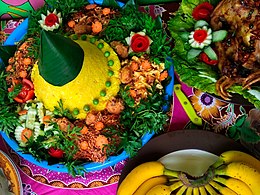
Back Bumbu (Würzmittel) German Anexo:Ingredientes de cocina Spanish Bumbu (cuisine) French Bumbu dapur ID Bumbu (gastronomia) Italian Bumbu JV Bumbu dapur MAP-BMS Pamasak MIN Boemboe Dutch Bumbu (tempero) Portuguese

 |
| This article is part of the series on |
| Indonesian cuisine Masakan Indonesia |
|---|
|
|
Bumbu is the Indonesian word for a blend of spices and for pastes and it commonly appears in the names of spice mixtures, sauces and seasoning pastes. The official Indonesian language dictionary describes bumbu as "various types of herbs and plants that have a pleasant aroma and flavour — such as ginger, turmeric, galangal, nutmeg and pepper — used to enhance the flavour of the food."[1]
It is a characteristic of Indonesian cuisine and its regional variants such as Balinese, Javanese, Sundanese, Padang, Batak and Manado cuisines. It is used with various meats, seafood and vegetables in stews, soups, barbecue, sotos, gulai, and also as an addition to Indonesian-style instant noodles.
Indonesians have developed original gastronomic themes with lemongrass and galangal, cardamom and chilies, tamarind and turmeric.[2]
Unlike Indian cooking tradition that favours dried spice powder mix, Indonesian cuisine is more akin to Thai, which favours the use of fresh ingredients. Traditionally, this mixture of spices and other aromatic ingredients is freshly ground into a moist paste using a mortar and pestle.[3]
The spice mixture is commonly made by slicing, chopping, grinding, beating, bruising, or sometimes dry-roasting the spices, using traditional cooking tools such as stone mortar and pestle, or a modern blender or food processor. The bumbu mixture is usually stir-fried in hot cooking oil first to release its aroma, prior to adding the main ingredient (usually meats, poultry, or fish).
The equivalent in the Malaysian cuisine is rempah.[4]
- ^ "Bumbu". KBBI.
- ^ "Indonesia: Spices". Global Gourmet. Archived from the original on 8 December 2015. Retrieved 8 December 2015.
- ^ Sri Owen (2014). Sri Owen's Indonesian Food. Pavilion Books. ISBN 9781909815476.
- ^ Sri Owen (2015). Indonesian Food. London: Pavilion. p. 170. ISBN 978-1-910496-71-8.
© MMXXIII Rich X Search. We shall prevail. All rights reserved. Rich X Search